An interview with Andy Hearn and Jo Ross,
Borneo wild cat researchers
Last year two independent teams of scientists announced the discovery of a new species of clouded leopard in Borneo. The news came as conservationists launched a major initiative to conserve a large area of forest on an island where logging and oil palm plantations have consumed vast expanses of highly biodiverse tropical rainforest over the past thirty years. Now a pair of researchers are racing against the clock to better understand the behavior and ecology of these rare cats to see how well they adapt to these changes in and around the Danum Valley in Malaysia’s Sabah state.
Andrew Hearn and Joanna Ross run the Bornean Wild Cat and Clouded Leopard Project — a collaboration between the Oxford based Global Canopy Programme, the WildCRU, University of Oxford, and the University Malaysia Sabah. The project aims to understand and protect Borneo’s threatened wild cats, which include the flat-headed cat (Prionailurus planiceps), marbled cat (Pardofelis marmorata) leopard cat (Prionailurus bengalensis) the endemic bay cat (Catopuma badia) and the Bornean clouded leopard (Neofelis diardi).
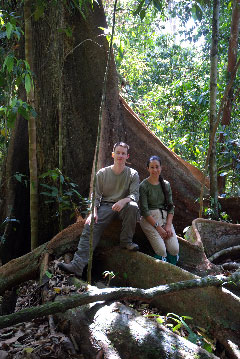 Hearn and Ross resting on one of Danum Valley’s giant Dipterocarp trees |
“Understanding the ecological requirements of these cats will enable the development of effective conservation strategies to help ensure these species’ survival,” Andy Hearn said.
“We’re working on all five species of cats here in Borneo but we’re focused mostly on the Bornean Clouded leopard because it has the potential to be a flagship species,” Jo Ross added.
Almost nothing is known about Borneo’s largest mammalian predator — its diet, range, habitat requirements, and abundance are all a mystery.
Hearn and Ross are using a combination of camera traps, radio telemetry for tagged individuals, and field sign surveys to compare the ecology, behavior and density of the five Bornean felid species in different forest types ranging from pristine rainforest to recently logged concessions. The researchers plan to eventually assess the viability of oil palm plantations as habitat for the cats. Still the work is difficult due to the rough terrain of Danum Valley and the large range and low density of the species — there are only a handful of Clouded Leopard per 100,000 square kilometers of habitat.
In April 2008, mongabay.com caught up with Hearn and Ross at the Danum Valley Field Center in Borneo.
AN INTERVIEW WITH ANDY HEARN AND JO ROSS
Mongabay: What are you working on here?
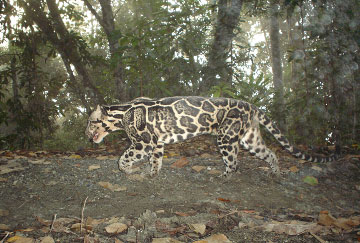 A male Bornean clouded leopard in the morning mist. Photo by Hearn and Ross |
Andy Hearn: The clouded leopards found on Borneo and Sumatra have recently been reclassified as a new species, distinct from those found throughout mainland Asia. We’re the first people to collar and track the Bornean Clouded Leopard.
Jo Ross: We’re working on all five species of cats here in Borneo but we’re focused mostly on the Bornean Clouded leopard because it has the potential to be a flagship species — a lot of people have heard of it. The species is also the largest cat in Borneo and endangered.
Mongabay.com: You have a lot of gear for locating and tracking cats. Do you ever feel that your work is more about information technology (IT) than biology?
Andy Hearn: Sometimes it feels that way. I like computers when they go right, but unfortunately they frequently don’t. The camera traps are fairly straightforward. I’ve built some of my own so I pretty much know how to fix them when something goes wrong. The software is trickier — there is so much to learn.
Mongabay.com: How often do you check the camera traps? How long do they last?
 Hearn and Ross downloading photo data from a digital camera trap set in the primary forest. |
Andy Hearn: It depends on the location and circumstances. For example one time one of our cameras was near an area where there was a fruiting tree frequented by bearded pigs. Our 512 MB card was filled with 270 shots of baby pigs running around. In areas with less activity the battery will die before the card is full. The batteries can last about 6 weeks in low traffic areas.
Mongabay.com: Where do you place the camera traps?
Andy Hearn: We’ve found that for cats, the best place to put traps is along old logging roads. At this stage we don’t know if cats preferentially use roads or whether we are simply more likely to photograph them in these areas. In primary forest we locate the cameras along animal and human trails.
We presently have about forty eight camera traps but will be increasing this number significantly soon.
Mongabay.com: Do you have physical problems with cameras in terms of theft or damage by animals?
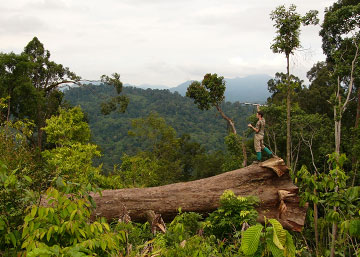 Hearn radio tracking a clouded leopard in the logged forest surround the Danum Valley. Photo by Rod Hearn |
Andy Hearn:
We’re lucky in that the cameras are in a protected area with a very low human presence, so theft hasn’t been a problem. It’s possible this could change when we start doing camera trapping in recently logged areas, edge forests, and oil palm plantations.
Damage from animals has been limited by the placement of the traps, but we’ve lost a couple of cameras to angry elephants. Housing the traps in metal boxes is helping to prevent elephant damage.
Mongabay.com: How else do you study rainforest cats?
Andy Hearn: We’ve collared one female clouded leopard who we’re tracking using radio telemetry, and we’re looking at the wild cats’ diet by analyzing their scats.
Because the Bornean Clouded Leopard has a large range we do a lot of driving. We rely heavily on logging roads.
Mongabay.com: What’s the next phase on your research?
Andy Hearn: We’re trying to get a handle on the effects of logging and oil palm conversion — first by seeing how animals use these forest types and how their abundance is affected. Density estimates will be based on camera trapping in forests of different quality — primary forest, secondary forest, and recently logged forest. We’ll also look at oil palm plantations.
Mongabay.com: What are the biggest threats to the Bornean Clouded Leopard?
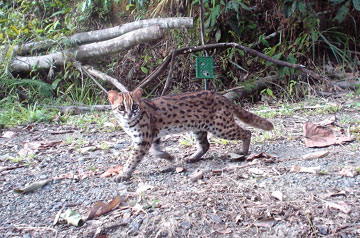 A Leopard cat, Borneo’s most common felid. Photo by Hearn and Ross |
Andy Hearn: One of our study animals was killed with a shotgun four months ago. It isn’t clear why it was shot, it might have been accidental, and the kind of thing where some guys were out hunting, saw two eyes, shot, and then found out it was a cat. It doesn’t look as if they targeted the cat on purpose — they didn’t take the skin or any other body part. No one has reported Bornean Clouded Leopard pelts on the mainland, so we don’t think there’s trade in the species. This isn’t the case with the Clouded Leopard found elsewhere. But there’s always the chance that it could happen. We’re told pangolins are smuggled out of Borneo. It’s not a problem at the moment but we need to be aware.
There’s not the same sort of human-wildlife conflict here that you see in other parts of the world. You occasionally hear about people losing chickens but it apparently doesn’t happen very often, so killing cats as pests is a lesser threat.
A bigger concern is depletion of their prey by hunting. This reduces the quality of their habitat by diminishing the abundance of prey. They probably aren’t targeted directly.
There is anecdotal evidence to suggest that they don’t go far into oil palm plantations, so I think most of the area cultivated for oil palm can be ruled out as habitat. With logging you get destruction of habitat and hunting of their prey.
Mongabay.com: What’s your background? How did you end up studying cats in Borneo?
Andy Hearn: I did my degree in Biology and went on to do a Masters in Conservation Biology, which is where I met Jo. I’ve always had a wide interest in all wildlife but I’ve always had a desire to work in the tropical rainforests.
We started off in Borneo. I did my masters research on orangutans, looking at abundance in logged forests in Kalimantan.
After that project, we returned to Borneo in 2003 to do orangutan population surveys on behalf of the Orangutan Foundation UK. We went to unsuveyed parts of Borneo in the hill forests of the Schwaner range. We would speak with village headmen to ask permission to go into their forests and about the presence of orangutans. We hired locals and traveled up river as far as we could go.
One time a headman agreed to take us to an area where there were orangutans. His men then loaded the boat with big chainsaws — it turned out they were illegal loggers. So we were not only hiring them as guides but giving them transportation to their logging area.
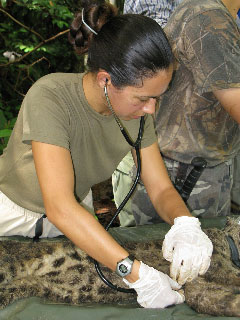 Jo Ross monitoring the heart rate of an immobilised cloudie. Photo by Hearn |
One morning at the site, a small ginger red cat walked out in front of me. The cat didn’t notice me and I drew some quick pictures. When I got back into the city, I did some research. It turned out to be one of the rarest cats in the world. No one knew anything about it and the species had never been photographed or videoed. That was it — my first interest in Borneo’s carnivores.
Jo and I went back to the U.K. when the project was over but we knew we wanted to go back to Borneo to study this mysterious animal, the Bay cat and Borneo’s other little known cats. We started looking for project funding while trying to make ends meet. Jo and I volunteered on conservation projects as well as undertaking paid work; I worked at a construction site and Jo did secretarial work. Eventually we approached the Global Canopy Program (GCP) for some ideas of where to go for funding. We were seeking a small amount of funding for the project but GCP encouraged us to approach the Darwin Initiative, a program run by DEFRA. It was a long shot but we ended up winning an award for a three-year project that involved not only research, but also conservation, training of locals, and education.
Jo Ross: I did my undergraduate work in environmental science followed by a Masters in Conservation Biology. I did my work in Kenya looking at the effects of the high density of elephants on a small reserve.
Later I came out to help Andy with his orangutan project in Kalimantan.
Mongabay.com: Do you have any advice for students aspiring to pursue field research?
Jo Ross: Perseverance is important, as is experience. Do as much fieldwork volunteering as an undergrad as possible so you don’t have to spend time doing it when you get out of school. There are loads of projects that will take people on a volunteering basis. If you can’t find opportunities for fieldwork, at least learn skills that can be applied to different situations.
Mongabay.com: What is the best way to ensure that Borneo’s wild cats are around in the future?
Jo Ross: I think the main thing for Sabah is to maintain sufficiently large areas of habitat or at least maintain corridors to areas of suitable habitat. At this stage we simply do not know how large these areas need to be. We do know that cats can survive in good quality forest 20 years after logging — and that the maintenance of these disturbed forests will be paramount to the continued survival of Borneo’s wild cats.
Mongabay.com: You mean the forest was logged 20 years ago and has regenerated, right?
Jo Ross: Yes, but one of the things we’re studying is how fast cats return after logging.
Mongabay.com: What about education?
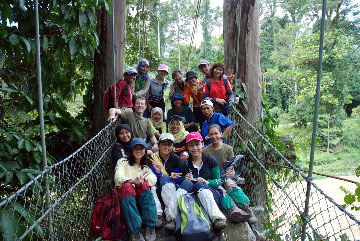 Group of Conservation Biology undergrads from the University Malaysia Sabah attending a course on ‘Mammal Field Research Techniques’ |
Jo Ross: I think education will help as well. We need to raise awareness among local people of the issues faced by the cats found in their country, and also to generate interest and pride in these cats. A lot of people think we’re studying tigers and they are surprised to learn they aren’t found in Borneo. As part of our project’s activities we are running ‘mammal field research techniques’ training courses for local undergrads. The main aim of this is to raise capacity for research in Sabah, but also to stimulate interest among Sabah’s future conservationists.